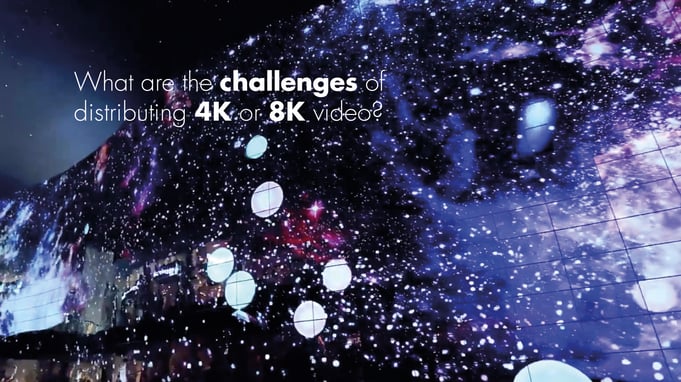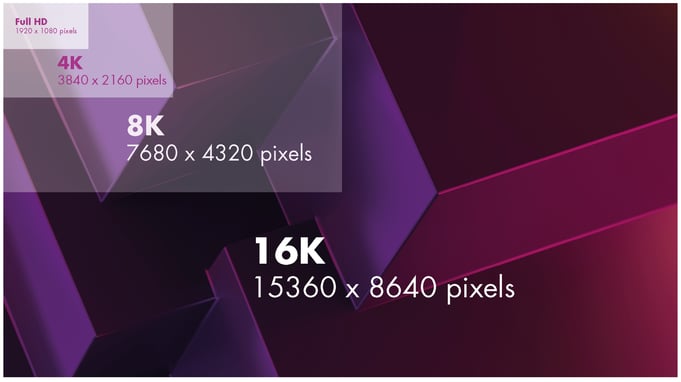
“4K video delivers stunning beauty and resolution. But like most new technology, it comes with challenges to overcome as well.” These were the opening sentences of a Crestron white paper, published in 2014. Now it says 2019 on the calendar, and we have a wide range of display technologies with 8K resolution. Are we ready to rumble or are we stuck with the same challenges?
Read on…
- Before you start
- 4K and 8K at a glance
- The 5 challenges of 4K distribution
- In conclusion…
Before you start
As a pre-read to this post, you might find my blog about the resolution race interesting. It covers the different resolutions in detail.
You'll find it here: 4K-8K-16K The race for higher resolutions is on!
4K and 8K AT A GLANCE

WHAT ARE THE 5 CHALLENGES OF 4K DISTRIBUTION?
In the Crestron white paper mentioned above, they identified five challenges related to the implementation of a video-centric installation with 4K. The challenges are:
- Mismatched resolutions
- Frame rate considerations
- Video signal integrity
- Cable length restrictions
- Source/display compatibility
Let's take a peek!
MISMATCHED RESOLUTIONS
720p, 1080i and 1080p all share the same aspect ratio (1,78:1 or 16:9) and this is what is found in almost all sources and displays. But 4K comes in two flavors:
- 4K UHD (3840 x 2160) has 1,78:1 or 16:9
- 4K (DCI – The Digital Cinema Initiatives, 4096x2160) has 1,90:1 or 17:9
This is not a major challenge, but still something that needs to be taken into consideration as you design your systems and workflow.
frame rate considerations
1080p video at 60 frames per second (fps) requires a data rate of 4.46 Gbit/s. When you know that 4K is in fact 4 times 1080p, the data rate should bump up to 17.84 Gbit/s. But as HDMI 1.4 is still the most used version of HDMI (2.0 is there and supports 18 Gbit/s data rates but its adoption by the market is limited). With that in mind, systems running HDMI 1.4 are limited to 4K at 30 fps.
Let's have a look at the data rates for different resolutions using the Extron calculator, all with 60 fps, 8bit color depth and 4:4:4 chroma sampling:
4K (UDH, 3840x2160) = 17.82 Gbps
4K (4096x2160) = 17.82 Gbps
5K (5120x2160) = 22.28 Gbps
8K (7680x4320) = 71.28 Gbps
10K (10240x4320) = 89.10 Gbps
If you go for compression with a different chroma subsampling, you get the requirements for 4K signals, according to the Crestron white paper (data rates include HDMI overhead):
4K (30fps, 4:4:4) = 8.91Gbps
4K (60fps, 4:2:0) = 8.91Gbps
Both resolutions are supported by HDMI 1.4 cable.
VIDEO SIGNAL INTEGRITY
Another challenge is that signal integrity requirements for 4K video are significantly higher than for HD (1080p). With analogue cables you could get a video signal across with some loss. But with digital signals – if you lose data – you lose the image.
The Crestron white paper has some great illustrations showing how jitter and signal loss dramatically increase with longer cables.
CABLE LENGTH RESTRICTIONS
Even prior to the introduction of 4K, the provision of decent cable lengths was problematic. The advent of 4K brought far more challenges, and now – with 8K and resolutions beyond that – there are even more. Even with compression (reduction in frame rates, chroma subsampling), distributing 4K or 8K video requires massive bandwidth. With that in mind, cable lengths are significantly shorter than what you could get with HD (1080p). This creates a new challenge for system designers, of course.
Let's look at HDMI as defined by the HDMI technical working group, and the requirements for data throughput for three levels of HDMI cables:
- High Speed HDMI: Up to 4K resolution at 30Hz – or 10.2Gbps data
- Premium High-Speed HDMI: Up to 4K resolution with high dynamic range (HDR) at up to 60Hz – or 18Gbps data
- Ultra High-Speed HDMI: Up to 10K resolution with HDR at a 120Hz refresh rate (4K video can refresh at up to 240Hz) – or 48Gbps data
And if you try to google “HDMI 4K cable” you are in for a treat. Options in the thousands – in other words, you need to be selective when choosing the right cable.
SOURCE/DISPLAY COMPATIBILITY
When new technology and resolutions are brought to the market, you have a “chicken and egg” situation: How can you perform interoperability testing with 4K or 8K (as we have now) when there are few of them available? When Crestron published their white paper, 4K devices were scarce. Today we have the same challenge with 8K. Having limited availability for testing, the compatibility among them can be imperfect - even compatibility issues between products from the same company can be a challenge.
in Conclusion…
4K is not new, but it is still a challenge to implement a full 4K, uncompressed workflow and system. With that in mind, 8K is going to be a challenge for many, many years to come.
More reading:
The Challenges of Distributing 4K Video, Crestron
8K resolution, Wikipedia
Are you ready for 8K, Advantech, The Broadcast Bridge
4K HDMI cables: How to cut throught the marketing lingo and figure out what you actually need, TechHive





